| HORSES |
YEAR: 1981
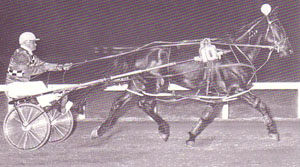 |
Roydon Scott, one of NZ's best pacers of the last decade, had to be put down at Roydon Lodge Stud last week.
The decision to put the grand pacer, who suffered very badly from arthritis, down, was taken by trainer Fred Fletcher after consultation with owner Roy McKenzie. "He was suffering a lot more than people realised," said Fletcher last week.
Roydon Scott still holds two NZ records and broke 2:00 on four occasions, taking his lifetime mark of 1:58.9 as a 3-year-old. In all, Roydon Scott raced only 49 times for 18 wins, five seconds, four thirds, three fourths and three fifths for stakes totalling $79,792.50.
During his career, he raced against and beat the best horses in the country, even when sorely troubled by arthritis late in his career. He missed several major events because of injury. Roydon Scott had his last race in the 1980 NZ Cup at Addington, finishing down the track, but brilliantly won his two lead-up races.
He was buried at Roydon Lodge.
Credit: NZ TrottingCalendar 20oct81
YEAR: 1981
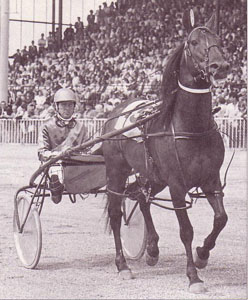 |
| Trusty Scott & Henderson Hunter |
The 1978 NZ Cup winner Trusty Scot, one of Southland's best pacers, has a cracked pastern in his off hind leg, and has run his last race. "He had me worried for a while," part owner and trainer Henderson Hunter said, referring to the serious nature of the injury. Trusty Scot suffered the cracked pastern after competing at the NZ Cup meeting at Addington in the week leading up to the Young Quinn flying mile at Wyndham at the end of November.
After racing his way through to Cup class in his 3 and 4-year-old years, Trusty Scot had a bone chip removed from a sesamoid in his near hind leg as an early 5-year-old and missed racing for most of that season. Hunter, who raced Trusty Scot with his father Adam Hunter, said he thought the extra pressure on his off-hind leg due to that first injury contributed to his breaking down in his other hind leg. Trusty Scot will be unable to serve mares this season but the 8-year-old Scottish Command entire from the Flying Song mare Fledgeling will commence stud duties at Edendale next spring. "We'll keep him down here and give Southlanders a chance to breed to him," Hunter said.
Trusty Scot retires with stake earnings of $128,545, the result of 96 starts for 21 wins and 29 placings, including a win at the Inter-Dominion Championships in Brisbane as a 4-year-old. Placed once in five starts at two, he gained prominence in his 3-year-old racing in a busy campaign, starting 25 times for five wins and 12 placings, and taking a 1:59.9 record when he won the Stan Andrews Stakes from Smokey Lopez and Bolton Byrd at Addington.
At four, he ran 21 times for seven wins, including the Ascot Park Flying Mile at Invercargill in 2:00.3, beating the star-studded field of Balgove, Sole Command, In Or Out, Forto Prontezza and Lunar Chance. He also won a heat of the NZ Messenger Championship and was runner-up to Stanley Rio in the final, won a heat of the Brisbane Inter-Dominion, and lowered his mile record to 1:57.6.
After missing his 5-year-old season because of injury, Trusty Scot came back better than ever at six, winning the Ashburton Flying Stakes first up, and the Kaikoura Cup before his most important successes, the 1978 NZ Cup from Sapling, the NZ Free-For-All three days later in 2:29.1 for the mobile 2000 metres, a mile rate of 2:00.1. Naturally, Hunter rates these wins as his best because he beat the top pacers, Sapling, Lord Module and company, when they were all going strong. Hunter also rates his performances in Australia at the Inter-Diminions, when he made a remarkable recovery to run third in a heat after losing a big stretch of ground early, and later at Perth the same season as he won the Cup, among the best in a fine career.
Trusty Scot contested the Inter-Dominion Championships at Christchurch as a late 6-year-old and wound up a strong-finishing fifth in the final after racing back in mid-field. His 7-year-old season was not a happy one. He struck difficulties racing off back marks, but he managed a good sixth in the NZ Cup after an early break, and won twice. This season, he led from end to end in the Quadroon Invitation Stakes at Gore, his last win, and was a strong finisher from the rear for fifth in the NZ Cup.
A genuine racehorse, with a clean gait, Trusty Scot is one of the best performed sons of Scottish Command.
Credit: Jeffery Scott writing in NZ Trotting Calendar 20Jan81
YEAR: 1981
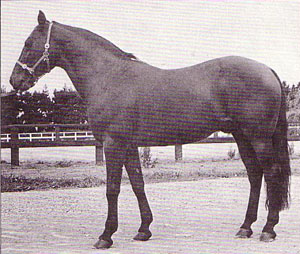 |
A trotting identity, who will long be remembered for the contribution he made to the industry - Garrison Hanover - had to be put down at Bill Denton's property at Tai Tapu last week. Garrison Hanover, who was 34, complied a memorable record as a stallion and, even as recently as last month, was represented by a yearling at the National Selected Sale.
Garrison Hanover was described by Bill Denton as "just like one of the family - he was older than any of our own children by quite a bit." He sired 984 foals in NZ and was represented in this country by 459 winners, for an average of 46.6%. Some of the top pacers he left included Cardinal Garrison (Auckland Cup, Great Northern and NSW Derby), Game Adios (NZ Derby), New Law (NZ Derby), Speedy Guest (G N Derby & NZ Messenger), Waitaki Hanover (G N Derby, Auckland Cup), Main Adios (NZ Derby), Apres Ski (1:56.2 the fastest of his 16 2:00 performers), Helen of Tara, Royal Count, Whispering Campaign and many more. Garrison Hanover was leading sire for three successive seasons form 1966-67 to 1968-69 and has proved a great success as a broodmare sire.
Garrison Hanover was imported to NZ in 1955 after being selected by Bill's father and Jack Shaw and apart from two seasons at Clem Scott's in Southland, stood all his life at Russley Lodge Stud, first at Templeton then at Tai Tapu. "He just got to the end of the road - his old machine gave out." Bill said last week when describing how Garrison Hanover suffered the heart attack which led to him being put down. "I knew he wouldn't come out of it and we wouldn't prolong his life any longer."
But Garrison Hanover has not left Russley Lodge. "I've got a nice spot organised for him here and will erect something a bit decent to mark his grave. It's the least I can do - everything I've got I owe to him," Bill said. Harness racing in NZ also owes a lot to Gerrison Hanover.
Credit: Tony Williams writing in NZ Trotting Calendar 17Mar81
YEAR: 1981
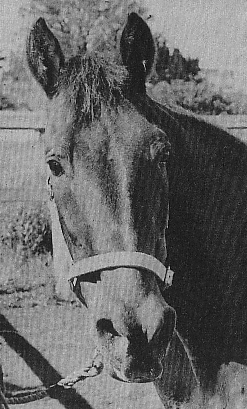 |
Young Charles, who died a few days ago at the grand age of 35, did much to underline the hard wearing qualities of the U Scott line.
"His death was sad, but easy to accept," his owner-breeder Bob Mayne said last week. "He ate up normally, did everything else as usual and quietly walked away and died," said Mr Mayne, a retired Christchurch cartage contractor.
As a racehorse and as a sire Young Charles was every inch an individual, being bred on the stout U Scott - Jack Potts cross. U Scott and Jack Potts both headed the NZ sires' list on nine occasions and Young Charles topped the list in 1975, the year of Young Quinn.
Foaled on October 25, 1946, Young Charles revealed immediate ability for trainer Colin Berkett, being champion 2-year-old and 3-year-old of his year. In all, he won 11 races and had 26 placings from 56 starts for $24,435, racing against the likes of Van Dieman, Johnny Globe, Vedette, Caduceus, Burns Night and Soangetaha. Hampered by tendon trouble once he attained Cup class rating, his courage won the hearts of many. Canterbury trotting men to this day maintain that his second to Johnny Globe in the 1954 NZ Cup 'on three legs' was one of the most memorable contests ever at Addington. Johnny Globe set a world two mile time of 4:07.6 in that race and Young Charles on a restricted preparation, recorded 4:10.8.
"My greatest thrills were his wins in the NZ Futurity Stakes and All-Aged Stakes at the Ashburton June meeting," Mr Mayne recalled. "Colin Berkett was a great feeder, and, as Young Charles had a wonderful constitution, he had to be worked really hard to give his best on the track," Mr Mayne said.
Young Charles' battle for recognition as a sire was certainly an uphill one. When retired to Mr Mayne's Yaldhurst property he received only eight mares and 11 the following season. He then had a season in Auckland before moving to Southland. Restricted as his early opportunities were, Young Charles slowly but surely acquired the respect of breeders, siring the likes of Danny's Pal (10 wins and 14 placings), Jacobite (12 wins and 9 placings), Valcador (10 wins and 12 placings), Lonesome Valley (9 wins and 12 placings) and Top Copy (9 wins and 21 placings).
Even better, however, was to come when he stood at Colin Baynes' Ferndale and Otama nurseries. Notable pacers conceived at those studs before he finished his Southland career at Des Baynes' Highway Farm, Edendale included Young Quinn (1:55), Sapling (1978-79 Pacer of the Year), Sassenach (1:58.6), Peter Onedin (1:56.8), Gurkha (1:58.2) and Ghandi ($225,000).
Young Charles has so far been credited with siring 165 winners and 20 in 2:00, from around 470 live foals an excellent percentage of 35. Only Local Light (23) and Lordship (22) have been more successful NZ-bred sires of 2:00 performers. "I always wanted him to make the top as a sire more than anything else in the world. When Young Quinn won the 1975 Inter-Dominion final in Auckland, that really put the icing on the cake for me," Mr Mayne said.
As a broodmare sire, Young Charles has now emerged as a real force. He has sired the dams of 122 winners (to July 31, 1981) and at least eight in 2:00 including Armbro Star (1:59.6), Testing Times (1:59.2), Loyal Drift (NZ Oaks), Smooth Charles (1:58.8) and Saucy Jack (Methven Cup).
One way or another, Young Charles has been a good horse to many trotting people all over NZ and many are grateful for the care he received right up until his death. Bob Mayne went to a lot of trouble to bury Young Charles in a special grave on his property last week. The influence of his old favourite promises to be felt as long as there is light harness racing in NZ. Sapling, his best performed entire son, has been heavily booked for his initial season at the Hokonui Stud, where he was conceived nine years ago and where Young Charles made his name as a sire.
Credit: Don Wright writing in NZ Trotting Calendar 22Sep81
YEAR: 1980
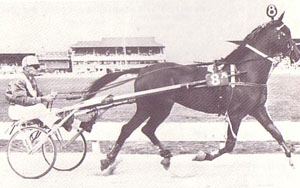 |
Former top trotter Johnny Gee was found dead in his paddock at Central Globe Lodge shortly before New Year. A veterinary examination showed he died of a heart attack. He was 19 years old.
In his racing career Johnny Gee won 28 races and gained 53 placings. His wins included the Dominion Handicap,The Canterbury Park, Banks Peninsula and Waimate Trotting Cups, and three Canterbury Park Stewards' Free-For-Alls, in one of which he set his record of 2:01.2
Johnny Gee was by the great Johnny Globe, four times leading sire, and was out of the Light Brigade mare Atone, who was Broodmare of the Year in 1971-72.
Johnny Gee's progeny are having a good year on the racetrack, led by the good trotter Cool Cat.
-o0o-
Ron Jenkins: Great Trotters
Johnny Gee retired in 1972 as NZ's greatest stakeswinning trotter - $64,690 - and as holder of the NZ mile race trotting record of 2:01 1/5. He was the winner of 27 of his 127 race starts. Among his successes were wins in the Canterbury Park Cup and the Dominion Handicap - the two prestige events for trotters in NZ.
He was the first foal of the champion broodmare Atone, a mare selected as the 1972 NZ Broodmare-of-the-Year. Sold as a yearling at the National Sales for 460 guineas, Johnny Gee was in turn leased to trainer Wes Butt who looked after the horse until his retirement. He was originally tried as a pacer, but was quickly switched to the trotting gait as he persistently crossfired.
During his career in NZ Johnny Gee won many races from difficult handicaps and was seldom beaten under free-for-all conditions. A number of his races were fought out against his stablemate, the Australian bred Tony Bear.
Credit: Ralph Kermode writing in NZ Trotting Calendar 8Jan80
YEAR: 1980
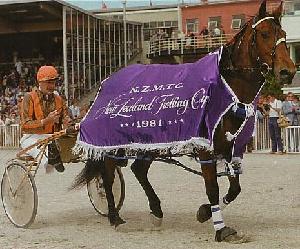 |
| Armalight (Bob Negus) parading after winning the 1981 NZ Cup |
Take a young filly, gifted from one brother to another, and a young man whose ambition is to own a bit of land where one day he can keep that filly and her foals, and the end result is Armalight and her owner, Brent Smith.
Armalight's rapid rise from 'just another maiden at Westport on Boxing Day' to he position as the best 3-year-old in the country is unusual in that her owner-trainer admits to "just learning about training as I go along." But the learning started a long time ago for 27-year-old Brent, back in the days when he helped his father, the late Howie Smith, with the training of Armalight's dam, Ar Miss.
Ar Miss, a daughter of Armbro Del and the Grattan Loyal mare Trixie Milne, proved an outstanding filly under Howie Smith's care, winning the NZ Sapling Stakes at only her second start when still a maiden, then going on to take the NZ Oaks later that same year. The Sapling-Oaks double was nothing new to Howie Smith at that time, for, nearly a quarter of a century before, he had trained Mr Andy Todd's outstanding filly Perpetua to win both classics.
Ar Miss was raced by Brent's older brother Vic, who was given her by his uncle, the late Ossie Smith. "Ossie gave her to Vic, and I guess he was sort of grateful at getting his start that way, so when Ar Miss started breeding, he promised me the first filly," Brent said when explaining how he came by Amalight. "The first foal by Nevele Romeo died, so we had this free return to Nevele R Stud. At that time Dad had a lot of time for Timely Knight. He really liked him, so Ar Miss was sent back there. I was just lucky that the resultant foal was a filly, her." he said.
That early experience gained with his father influenced young Brent to try his hand at training Armalight himself, a big gamble for a young man with a very valuable filly. "I sent her to Ron Carter to break in, thinking I had better do everything right, rather than risk mucking her up myself. Then after a couple of runs at the trials as a 2-year-old, there was the temptation to go for the Sapling Stakes. Eventually I decided no. Take it easy and do it right."
The experience he gained with his father has proved invaluable to Brent, even though he is the first to admit he still has a great deal to learn. "I always enjoyed the practical side of it with Dad, and I can only go by what I learned working with him. The rest I have just had to find out from others. Bob Negus (the man who drove Armalight in her early racing) and Jack Carmichael have been a great help. I suppose they must get sick of me asking all these questions, but all I can do is learn from them until they have had enough," Brent said.
Bob Negus came into the Armalight story at the same time she opened her racing career. "I had her entered for the Champion Stakes at Ashburton on Boxing Day and a maiden race at Westport the same day. I gave a bit of thought and decided the Champion Stakes might be a bit tough, so I had to find a driver for her at Westport. I knew Bob a little, I was best man for one of his sons, and he was going to Westport with Scholar. He agreed to drive her," Brent said.
That Armalight won her first event is now history, but her record since belies her modest start. Two seconds , both at Nelson - beaten narrowly by the talented Regal Guy and Treasurer respectively - at only her second and third outings, caught the eye of the trotting public and Armalight and her young owner were on their way. Immediately after her Nelson second came the offer for Armalight that Brent now has no regrets he could not accept. "At the time, it would have meant $50,000 in my hand," he recalled. That bit of land was in the back of Brent's mind as Armalight underwent the veterinary examination to confirm the sale. But her off-front hoof, which had been slightly deformed since birth, failed to stand up to the searching veterinary examination for such a big deal, and the sale fell through. You couldn't blame the vet for turning her down on it," said Brent. "The wall of the hoof grows forward instead of down and at that stage she had raced only three times and it was impossible to tell if it would worry her later. Now I'm not sorry she did not pass the examination. I have no regrets at all."
That's not surprising in view of Armalight's record since, six wins, including three heats of the DB Flying Fillies Series and the NZ Metropolitan Championship, and a nose defeat by Armbro Wings in the Great Northern Derby. Though she was beaten only a nose in the Great Northern Derby, Brent surprisingly describes the race as a non-event as far as he was concerned. "I was sitting in the trainers' stand, with Alec Milne actually, and at the 600 metres I knew she had no show from where she was. I thought she had finished fifth, then Alec (who had produced Armbro Wings to win) was shaking my hand saying 'I've done it, I've won'. I started to walk down to the birdcage and somebody came up and said I was fourth. Ten yards further on somebody said I was third, then in the birdcage somebody came up and said I was second, beaten a nose. I thought 'this is good, another ten yards and I'll have won it', but it wasn't really such a nervous time as I would have thought."
Nerves are something Brent has found out about in the past few months, and he admitted not sleeping very well sometimes. The pressure which goes with training such an outstanding filly is something he didn't really think about until he walked Armalight into the birdcage at Timaru for a DB Fillies' heat. "It wasn't until I heard an announcement over the course speaker that she was paying $1.60 to win and 60 cents for a place that it really hit me. I thought 'hello' and it was only then that I realised that there were more people than just myself involved." Until that time, Brent only had the worry of wondering whether he was doing everything possible for the filly, and doing it the right way. He still has that worry, plus the added burden of knowing that Armalight, and to a lesser extent himself, are public property.
Initially, Brent worried mainly about his own abilities. "All I could do, and really still can, is get her as fit as I can, then it's up to her and her driver." But the pressure builds up as each big race approaches, and it can't be an easy thing for a young man with his first horse to handle. The interview was conducted nine days prior to Armalight contesting last Friday's NZ Oaks, and since her win in the NZ Metropolitan 3-year-old Championship at Easter, Armalight had caused her young trainer more than average concern. "I didn't really think she could win that one. I honestly thought she wasn't in the race. I thought I hadn't made one of the payments, but when I got back from Auckland, there she was in the field. I had given her four days off after Auckland so I thought she would be a bit short of work for it." Short of work or not, Armalight proved her complete class by beating a strong field of colts and geldings in record time of 3:23.1 for the 2600 metres, and she did it without being pressured.
Then the trouble started. After she cooled out following that win, Brent discovered Armalight was lame in her near foreleg. "She was as lame as anything when I went to put her on the float and take her home. The next morning, thankfully, it proved to be a stone bruise coming out, nothing as serious as I first thought. I was going to give her four days off anyway, so it did not affect her preparation too much." But before the stone bruise came out, Brent's real worry was that the injury to her near foreleg was caused by her exerting too much pressure on it because of her problem off foreleg.
So far, thankfully, the off front hoof has not caused her any worries, other than making he walk with a peculiar 'roll'. Once travelling at speed, she shows no sign of it. Brent gives all the credit for overcoming her hoof problem to farrier Ron Gibbons. "He spent a lot of time with her and we tried a lot of ways of shoeing her before we got it right. She has a pad under the shoe to build her hoof up to the correct height on that side, and it's thanks to Ron she's had no problems." Ron Gibbons' patience with Armalight has, or will have it's reward though, in the form of a new pair of boots. "I promised Ron that if she won the Metropolitan Stakes I would buy him a new pair of boots. He is always complaining about his footwear, so I made the promise and now I'll have to go out and buy them."
Tom Ryder, who boards Armalight at his Wigram Road property, also comes in for a lot of thanks from Brent. "It's good of Tom to let me keep her there, and he has done a lot to help too," he said. Latest in the list of Brent's 'advisers' is Templeton horseman Jack Carmichael, who drove Armalight for the first time in the Metropolitan Stakes. Brent has been taking Armalight to Carmichael's for fast work in recent weeks. It was because of his association with Ar Miss that Carmichael was offered the drive on Armalight in the Oaks, Bob Negus having to turn down the drive because of having his own filly, Elfin, engaged. "Jack drove Ar miss to win the Oaks for Dad, so he seemed a suitable choice to drive her when Bob advised me to get somebody else," Brent said. Brent gives Bob the credit for Armalight's rapid improvement from the time she started racing. "Bob was really good, teaching her about racing at every start and not knocking her about. She was just another maiden at Westport, but thanks to him she has kept on improving at every start since."
To Brent and his wife Carol, Armalight is more than just a champion filly, of for that matter a ticket to a new house. Brent's affection for the filly has been there since he took possession of her "as a fluffy little thing only that high". Carol's liking for the filly is something that has grown. "Carol was scared of her even when she was only a little thing. Now, she's as proud of her as I am. She treats her like a pet. Carol's had a fair bit to put up with, living in a flat the five years we've been married. We could have been in our own home a while back, but that really took second place to Armalight." Now, thanks to Armalight, Brent and Carol are that much closer to having their home, plus the land Brent wants to keep Armalight and her foals on when he starts breeding from her. And how far away is that day? "I'll race her as a 4-year-old, provided she comes up well, then she'll go to stud. She is too valuable to risk over-racing her," Brent said.
Brent is not worried at the prospect of Armalight ending the season with an open company assessment if she happened to win her three remining engagements this season. "No, I'm not worried about that if it happens. I can't really see her winning all three races, but even if she did, she would only be aimed at 4-year-old events like the Messenger next season." At the time of this interview, Armalight's own personal 'triple crown' was the NZ Oaks, the Great Northern Oaks, and the final of the DB Flying Fillies' Stakes. "I would like her to win the Oaks. Her dam did, but the DB Flying Fillies' would also be a nice one to win. She's won three of the heats and to win the final would really be good."
Armalight proved unbeatable in each of the three DB heats she contested, winning the first at Addington comfortably in 2:03.4, the second at Timaru in 2:02, then becoming the first filly to pace the mile in under 2:00 when she won her Auckland heat by eight lengths in a brilliant 1:59.1 without being pushed. But even these brilliant efforts don't rate with Brent as her best. He names the Celebrity Stakes at Addington between her first two DB heats as her best effort. That night, Armalight outclassed a strong field of colts and geldings over a mile in 2:00.5.
Because of her ability on the racetrack, even Brent has to forgive her little foilbles at home. Her favourite trick, until they fashioned a special frame to stop her was to turn on the tap over the water trough. "Tom Ryder kept blaming me for leaving the tap on, until we found out it was her," Brent said. "Even after we put the frame round the tap, it only took her a month to figure out how to get round that, so we had to put a bar across the top. That stopped her, but now I can hardly get my hand in to turn the tap on." Armalight also has a habit of rubbing her mane against the fence rails, and not even sacks round the rails stops her. "This makes her mane ragged and annoys Carol, who likes to have her looking her best," Brent said.
But believe it or not, It's one of Armalight's little tricks that helps Brent know when she's fit. "If I tickle her under the tummy and she tries to kick the daylights out of me, then she's fit. If she doesn't kick, then it's time to start worrying."
Credit: Tony Williams writing in NZ Trotting Calendar 29Apr80
YEAR: 1980
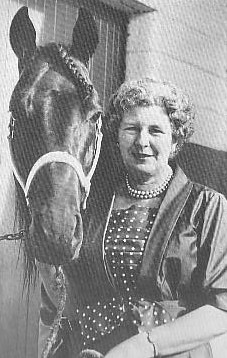 |
| Doris Nyhan & Lordship in 1962 |
When Don and Doris Nyhan established their stables at Templeton 30 years ago they named it Globe Lodge as a tribute to the immortal sire, Globe Derby.
About this time they raced Johnny Globe, a grandson of Globe Derby, who wrote a colourful chapter into NZ light-harness history through his deeds on the track and as a sire. And now it is a son of former public idol Johnny Globe, Lordship, who is keeping the stud to the fore in a manner which promises to make his chapter longer and more memorable than that of his father.
Globe Lodge the Nyhan property might be, but Lordship is 'Lord of the Manor'. He is currently 'King of the Sires'. At this stage of the season, most trotting folk reflect on the season and look to the statisticians to tell them who is top of what. The sires' table is one of these categories, which has a certain amount of prestige. Lordship has not only headed it this season, he has set a record. And in doing so, he has shown complete contempt for his rival sires. This season his progeny have amassed around $350,000 on the track, which is over $150,000 more than the next sire on the list and well over $100,000 more than the previous record earnings for a season.
In the past, most sires have reached the head of the table through the deeds of one or two major contributors. When these horses' earnings have been subtracted from their sire's totals, the stallion has fallen below the number one spot. This is far from the case with Lordship. If there had never been a Lord Module, Lordship's main winner this season, he would still be a clear leader on the premiership table.
The Lordship story started a long time ago when Mrs Nyhan took pity on a scruffy looking foal and persuaded Don, much against his judgement, to spend the £50 they had caved to buy a fur coat to buy the colt. The colt was Johnny Globe. With his son Lordship, Johnny Globe returned over £200,000, the result of 79 wins, for the sacrificed £50. The Nyhans came upon Lordship almost as fortuitously as his dad. Mrs Nyhan, at the invitation of a friend, leased the mare Ladyship, who was bred in the purple but had shown very little on the track. She put Ladyship to Johnny Globe. The result? Lordship. Ladyship was by U Scott from a fine racemare in Lightning Lady, who was a sister to a brilliant pacer in his day in Emulous, one of a select few who could match strides with the mighty Highland Fling. Lightning Lady was by Jack Potts from Light Wings, a mare imported into this country by Sir John McKenzie.
It didn't take long for Lordship to reveal special talents. "We knew we had something different when he was a yearling. He could work half a mile free-legged in a minute without any difficulty," Don recalled last week. Lordship fulfilled that early promise in his first season. He won six of his nine starts as a 2-year-old, including the 1961 Sapling Stakes. Lordship's regular driver Denis Nyhan, Don's younger son, recalled how Lordship wasn't happy on wet tracks when a juvenile. In many cases it was his class that took him through.
Just a young man at that stage and working at the stables, Denis got the regular drive on Lordship with a stroke of luck. Denis Nyhan tells the story. "On the morning Lordship was due to start in the Welcome Stakes I was following Dad in a workout when his horse cracked a bone in one of his forelegs and fell. I piled over the top of him and Dad was quite badly hurt," Denis said. "I got the drive then and won the Welcome. I was lucky enough to win the following three races with him, so Mum decided to keep me on," Denis said.
Lordship returned the next season and won five races including the NZ Derby by six lengths. However it was later that season that he gave a true testimony to his class. After finishing an unlucky second to Waitaki Hanover in the Great Northern Derby, Lordship took on the open class horses. He finished out of the money in his first few attempts before running third in the 1962 Easter Cup to Patchwork and then winning the Winter Free-For-All at Addington. In that event he decisively beat horses of the calibre of Falehood, Samantha, Blue Prince, Diamond Hanover, Gildirect, King Hal, Master Alan and Queen Ngaio. No 3-year-old before or since has ever done this.
Lordship was quite superb as a 4-year-old winning eight races including the NZ Cup, only the second of his age to do so. But it could have been quite different. Lordship almost never started in the Cup. A torrential downpour on the day prompted the Nyhans to consider scratching him. But officials reminded Don of all those off-course investors who had bet on Lordship and persuaded him to start. Lordship eventually strolled to an easy win for Mrs Nyhan. Denis, in the cart again, was having his first Cup drive. The overseas offers were soon flowing in for the brilliant black. Mrs Nyhan was adamant. Her pride and joy would not go to America. Her decision was to have a profound effect on the record books later.
However, it was the following season, 1963-64, that Lordship developed splint trouble which required daily treatment. But even though handicapped by his legs and lengthy marks, Lordship continued to win many races including his second NZ Cup, and Auckland Cup and two Easter Cups. And so grew a deep affection with the public which saw him become an idol in the mould of his dad.
Don and Denis Nyhan agree that his Auckland Cup win in 1964 was his greatest victory. He had to beat unsoundness, some other top horses and his handicap. "He was sore only a month or so beforehand and was far from being trained for a searching two-mile test," Don recalled. However, he came through with flying colours from his 36 yard back mark, by shading Jay Ar, with Great Adios and Vanderford filling the minor placings. "They went 4:11.4 that night. I'm sure if they had gone faster up front, he would have beaten Johnny's record - 4:07.6 - he was travelling that well throughout," Denis said.
Lordship retired as a 10-year-old with a record unequalled by a horse raced solely in NZ. As the winner of 45 races, including 16 free-for-alls, and $120,660 in stakes, he had eclipsed Johnny Globe's previous records. If he had won the same races today, his stakes winnings would have been anything from $450,00 to half a millon dollars.
And so Lordship went into his stud career with many hoping he could leave somthing as good as himself and perhaps carry on the Globe Derby male line. He has done this in no uncertain terms in the form of Lord Module. However it wasn't an easy road to haul. Lordship's support early on was moderate to say the least and it was only his ability that finally won him full book support. Only now, as a 22-year-old, is he getting the support he deserved in the first place. Don can't explain or understand the attitude of NZ breeders. "It's the same with any NZ-bred horse; it's an uphill battle," Nyhan said. "It was the same with Johnny. He never had a full book in his entire stud career, even when he was four times leading sire. And a lot of his mares were hacks," he said when recalling the support for Johnny Globe, one of the most admired horses ever.
"A mare could go to Johnny Globe and a top-class horse would often result. But send the same mare to U Scott, Light Brigade, Garrison Hanover or any other top sire, and she'd leave nothing," Don said. "Take Raidette, for example. When put to Johnny she left Radiant Globe, who almost won a NZ Cup, but to half a dozen matings with other sires, she left very little," he said. Don was also critical of the many breeders who flock to patronise imported sires in preference to our own champion horses. "A real battler here, who no one would even consider sending a mare to, can go to America and run 1:56 or 1:57, but bring an American-bred stallion here who went 2:00 as a 3-year-old, and they queue up at the back door," Don said. But now, it seems, breeders are only too aware of Lordship's siring prowess.
In the last couple of seasons, about a decade after his first crop hit the tracks, Lordship's book has been practically full and next season he will be one of the few stallions in the country standing at a fee of $1500. His service fee for his first season was a minute $210. Like Johnny Globe, Lordship was a tough and game pacer and he is passing these attributes onto his progeny. Although his good racehorses are too numerous to mention, some of the really top ones include Noble Lord, Jason King (Australia), Micron, Tricky Dick, Regal Light, Relinquish, Lordable, Single Lord, Trio, Tay Bridge and, of course, Lord Module.
At this stage he has left 137 winners. And with the oldest of his progeny only 12, he has already left several mares who have left winners. In fact, the first mare he covered, Lady Moose, left the talented pacer Lord Moose. Other up-and-coming horses to come out of Lordship mares include Captain Knight (1:59), Glen Moria, Jazzman and Poker Night. He is currently fifth on the 2:00 list with 14, including the fastest horse bred outside America, Lord Module (1:54.9).
Although very quiet and reasonably placid now, Lordship had a tremendous amount of nervous energy when a youngster. "I remember how he used to kick at the start and how one day he broke part of the sulky," Denis recalled. "And he used to get so wound up that he would trot round in his box for ages, just because of his nervousness. However he is a very intelligent horse. Whenever he went away, whether it was Auckland or to Dunedin, and we turned off the main road onto ours, 'Lordy' used to throw his head out of the float and start clawing the floor," Denis said. "He knew exactly where home was."
A routine day at Globe Lodge for Lordy these days is a lazy one. "He will spend part of the morning in a yard, lunchtime in a paddock and then he will sleep for the rest of the day in his box," Don said. For a stallion, Lordship is surprisingly tolerant. "We've got 11 and 12-year-old kids around here that can do anything with him," Don said. However, there is no doubt that Lordship, still as black as ever, will be boss around the place for a while yet. His dislike for strangers will be around also. He took a lunge at me - the last of several during the interview - just before I left the stable. He missed out on a souvenir. "The Lord" is hail and hearty. He wears the sire's crown proudly.
-o0o-
Mike Grainger writing in HRWeekly 9Aug89
Lordship was put down at his Globe Lodge home yesterday afternoon. The decision came just a month after he was withdrawn from service as a sire.
"He was one of the family," said Barry Nyhan. "Thirty one years is a long time here, but he has been withering away and hasn't been eating the same. He has been getting skinnier and skinnier and in the last fortnight his kidneys have started to pack up," he said.
Prebbleton veterinarian John Shaw has been monitoring the old horse's health over the last fortnight and advised the Nyhan family that it would be "cruel in the long run" continuing his present existence. "He was still shuffling around, picking a bit of grass," said Barry.
Lordship was rare in that he was a champion racehorse, a champion sire and a champion brood-mare sire.
He won 45 races, including two NZ Cups. His siring career has kept the Globe Derby line at full steam, though there are no firm leads as to who his successor will be, or even if there will be one. Lordship has 82 on the 2:00 list, and three on the 1:55 list - First Mate 1:54.8, Lord Module 1:54.9 and Templar 1:55. A past champion sire, Lordship has twice been leading broodmare sire.
His contribution to the breeding industry in New Zealand and Australia will be effective for many generations to come.
Credit: Frank Marrion writing in NZ Trotting Calendar 22Jul80
YEAR: 1979
SCOTTISH HANOVER
The honour of being NZ's leading sire of stake-earners for the 1978-79 season falls again to Roydon Lodge's sire Scottish Hanover. And who better to be his best representative than Roydon Lodge's own star performer, Wellington Cup winner Roydon Scott.
Epitomising much that is typical of Scottish Hanover's stock - speed, size, great staying ability and durability, Roydon Scott did much to enhance the already growing stature of Scottish Hanover, who looks destined to go down in our record books as one of the most influential sires of the late seventies and early eighties. Scottish Hanover's siring career has been notable for his remarkable consistency in leaving quality fillies and colts each year, and all improving with age. Breeders, after a slow start, have now recognised these qualities and have ensured his book has been near full each season.
The decision of Mr Roy McKenzie, managing director of Roydon Lodge, to purchase Scottish Hanover in 1966 for stud duties in NZ was a fortunate one for our breeding and racing industry. With such an excellent record of having stood previous top sires like Light Brigade, U Scott, Captain Adios and Thurber Frost in past seasons, it was hardly surprising that Roy McKenzie chose such a worthy successor. To quote Roy McKenzie's reasons for purchasing him: "Apart from his good race record in his races, he always finished strongly and usually covered extra distance, as Saunders Russell's wife did not like him driving horses and was only happy about his doing so if he kept out of a packed field, which often meant he raced one out in the death seat!"
Allied to his obvious racing ability (he paced 1:59 as a 3-year-old and 1:57.2 as a 4-year-old) was the appeal of his pedigree, which had a double strain of Scotland blood so successful in NZ with U Scott and the mare Minnetonka, who was the second dam of Light Brigade. The Peter The Great line in NZ has enjoyed great success under our racing conditions, through siring sons like Wrack and grandsons like Dillon Hall. The greatest influence, however, has occurred with Volomite's siring descendants (Light Brigade, Out To Win, Local Light, Fallacy, Tuft etc.) and Scotland's (U Scott, Scottish Hanover, Young Charles, Scottish Command, etc.)
Scottish Hanover's bloodlines have crossed well with most, and his stream of winners now exceeds 132, with over 12 in 2:00, inclding horses of the calibre of ...
~ Roydon Roux, a champion filly whose nine wins included a NZ Golden Slipper stakes and Great Northern Derby.
~ Final Curtain p, 1:59.6 - the winner of 18 races and 24 places.
~ Palestine - whose list of notable wins includes a Wellington Cup.
~ Roydon Scott p, 1:58.9 - the brilliant winner of the 1979 Wellington Cup.
~ Hanover Don p, 1:58 - an excellent performer in USA.
~ La Roue and Kara Kara - excellent racemares.
~ Classiebawn - winner of NZ Standardbred Breeders Stakes.
~ Scottish Heath - a durable type who competed with distinction at this year's InterDominion.
~ Watbro - a leading Southland 4-year-old.
~ Gretna Hanover - a leading North Island 3-year-old filly.
If past records are anything to go on, it will be in the broodmare field that Scottish Hanover will make a new impact, and Roy McKenzie expects his mares to be excellent producers in the years ahead - a pattern followed incidentally, by his other leading sires, Light Brigade and U Scott.
For the future, it is pleasing to see some of Scottish Hanover's sons being retained with a view to stud duties. Palestine, one of his best pacing sons, is being given a chance at stud, while Roy McKenzie is considering Roydon Scott's full brother Dreamover for a possible stud career once his racing days are over. There would be nothing more tragic to our breeding industry that to have such an excellent sire's bloodlines lost to out racing and breeding scene.
Credit: Ron Bisman writing in DB Trotting Annual 1979
YEAR: 1977
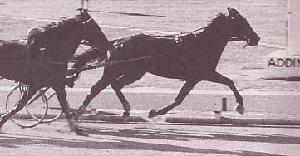 |
The ghost of numerous champion trotters of past eras and their connections must have watched in satisfaction on Saturday night (19 February 1977) as the brilliant Nigel Craig scooted over a mile in 1:58.8 shattering his own outright mile record of 2:00.3 and embarrassing the previous time trial record of 2:02.4 held by Control.
Driven by part-owner Bevan Heron and assisted by a galloping pacemaker in Glenroy Lass driven by John Noble, Nigel Craig went his first quarter in a brilliant 29.9 and reached the half in 58.4. The large crowd sensed the long-awaited two-minute mark for a trotter in NZ was on as Heron steered his horse through the third-quarter pole in 1:27.5. Urged on over the final stages, Nigel Craig showed all his great staying ability to reach the post in a time which was probably faster than most expected.
The winner of nine races this season alone and nearly $30,000, Nigel Graig has all the credentials to be a fitting holder of our first home two-minute trotting mark (Ordeal broke two-minutes in America some years ago) and the time he set is going to make things difficult for the number of horses getting ready for similar time trials in various parts of NZ and Australia.
Turned out in tremendous condition by his trainer Lance Heron, Nigel Craig won $2,100 for his effort on Saturday as a result of various sponsorships. From the Addington clubs the horse owners received $500 for appearing, $100 for breaking two-minutes and $100 for each tenth of a second under two-minutes. The Canterbury Owners and Breeders gave $500 for the two-minute mark being beaten.
Although not the only trotter in the country capable of going two-minutes, Nigel Craig deserved the honour as the first to go under that mark, for he has held the race record for more than 12 months, lowering it twice in that period. He is not a horse who would win show ring ribbons for looks, but there is little doubt now that he is a great trotter, perhaps one of the five best the country has ever sent. He has had a busy season but you wouldn't know it by his latest run, and his continuing good form is a credit to his handlers.
Credit: David McCarthy writing in NZ Trotguide 23Feb77
YEAR: 1977
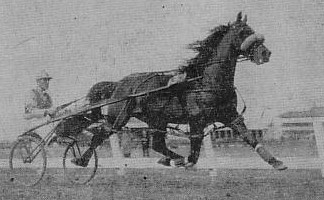 |
One of the more remarkable successes at stud in this country over the last 30 years was undoubtedly Springfield Globe, an Australian bred and owned track champion of the war years.
Though by the great Globe Derby, Springfield Globe had plenty of NZ blood in his veins being from the Logan Pointer mare Ayr, who traced to a thoroughbred taproot. Ayr was bred by Durbar Lodge and sold cheaply to Australia (less than $100) where she was a great breeding success. Springfield Globe was her best known son and won 15 races including the 1939 Inter-Dominions after his full-brother Our Globe had been sensationally disqualified for allegedly not trying in the third series of heats, after winning easily in the first two.
Early in the war years, Springfield Globe was leased to the Springston trainer Roy Berry. He won six races in NZ from a limited campaign, including the Autumn Free For All and the NZ Pacing Championship, the latter including Haughty and Gold Bar in the field. He was rated two minute material by his NZ handlers but acquired something of a reputation as a non-stayer, probably as a result of his abortative chase after Gold Bar in the 1943 NZ Cup. He was later to sire our first two-minute racehorse, but his stud career showed that his stock could match most in the staying field.
Springfield Globe had a rather remarkable stud career. He stood only six seasons in this country and was leading Colonial sire six times. He produced over 100 winners here and nearer 300 altogether. His best son was Tactician, the winner of 20 races and our first local two-minute racehorse, recording 1:59.8. Tactician was also rated by some experts as a non-stayer, but circumstances rather than an weakness, may have contributed to this belief. Tactician, of course, won an Inter-Dominion in 1955, in Auckland.
Thelma Globe was another outstanding racehorse, winning 17 races including an Auckland Cup. She took a national mark of 2:32.6 over 1¼ miles. Globe Direct, from one of the sire's earlier crops, was a fine racehorse too, winning 14 races and taking a 3:09.4 mark over 1½ miles on the grass. Springfield Globe sired two NZ Cup winners in Adorian (12 wins) and Mobile Globe, who defeated Tactician in 1952. His daughters produced two more Cup winners in Invicta and Cairnbrae.
Croughton, a fine juvenile racehorse before being claimed by unsoundness, classic winning mare Perpetua, Springbok, Victory Globe (Auckland Cup), Mighty Song, Lady Rowan, Super Globe, Fortuna, Gay Knight, Gay Heritage and Lady Joss (Australasian record holder) were some of Springfield Globe's stock to reach the top but by no means all. Au Revoir won 11 races and Ohio one fewer. Autumn Sky was successful on the track and was also a fine broodmare as was Safeguard. Prince Regent won a number of races as did Alouette, Chandelier, Agricola and First Globe.
The Globe Derby line has produced some disappointing broodmare sires, but Springfield Globe, probably as a result of the Logan Pointer blood, was not one. In NZ alone his daughters produced one hundred and eight winners. One of the best was Scottish Command who won 16 races and was rated by his connections as unlucky not to win the NZ Cup in 1959 when he was brought down on the turn. He of course has been a successful sire as well. Lochgair, Invicta, Dignus, Queen Ngaio and Cairnbrae were other top horses produced in this country by Springfield Globe mares, and there were many more in Australia including Thelma Globe's son Blazing Globe.
Dessonaire produced six winners in Australia. Modern Globe, winner herself of five, produced five winners including Student. Spring Lily was also the dam of five winners as was Mercias. All the stock of another Springfield Globe mare, Primeavel, went to the USA and six of them won races. Phyllis Globe produced Bob Again who won eight and Perpetua was the dam of top Australian pacer Dale Spring. Fairfield was the dam of seven winners and Heather Globe was the dam of four. The fertility of Springfield Globe mares was marked, another top matron being Silver Circle who was the dam of six winners. Fortuna was also successful at the stud.
Springfield Globe's sons did well in this country. Springbok was the sire of the top class pacer Oreti and a champion trotter in Durban Chief, both of whom distinguished themselves in the USA. Croughton, in his first season, sired a top mare in Beau Marie. Super Globe also did well as did Globe Direct. Henry of Navarre, from limited opportunities sired some good trotters, the best being Control who held the mile record for some years. Bastille, who died after a short stud term, was another Springfield Globe stallion to attract attention and Ayrland's Pride also sired a few winners. A number of his sons were exported to Australia. Harlequin Parade was sent across the Tasman after a very successful track career here and he was from the Springfield Globe mare Liliacae.
Two other sires by Springfield Globe have done well in this country. Prince Regent, a talented but unsound racehorse sired a number of winners and his daughter Princess Grace is the dam of Vanadium among others. Prince Charming, also a good racehorse, gained belated fame through the success of his sons Royal Ascot and Marawaru.
In Australia, Springfield Globe's sons have been most successful. Aachen, an outstanding racehorse who won his first 20 races in a row, has been a consistently outstanding sire across the Tasman and a number of his sons stand at stud there. Aachen has sired over 260 winners. Mineral Spring and the ill fated Sheffield Globe have done well there also and another son, Chief Spring has sired, among many winners, the champion Reichman.
It can be seen then, why some breeders are still anxious to have Springfield Globe blood in the veins of their mares. Whether it affects their staying ability is debatable, but there can be no doubt it is a great asset if you are trying to breed a winner.
Credit: David McCarthy writing in NZ Trotguide 18May77
| << PREVIOUS | 1 2 3 4 5 6 7 8 9 10 11 12 13 14 15 16 17 18 19 20 | NEXT >> |